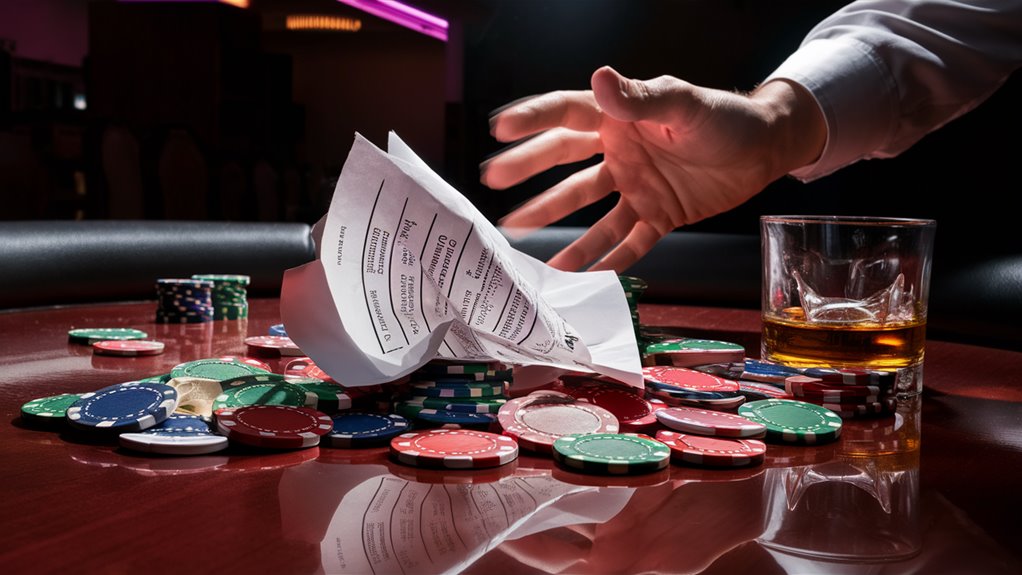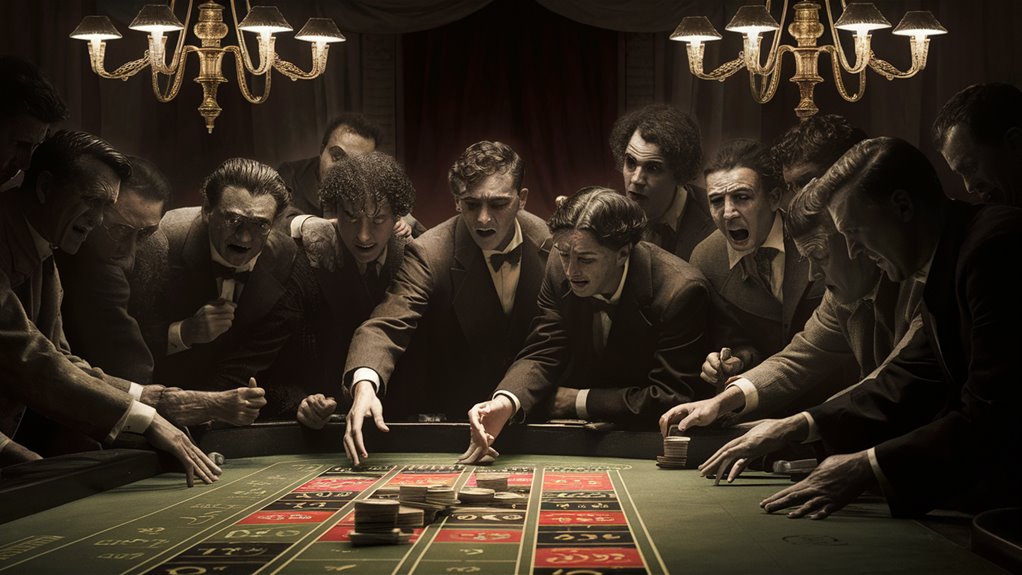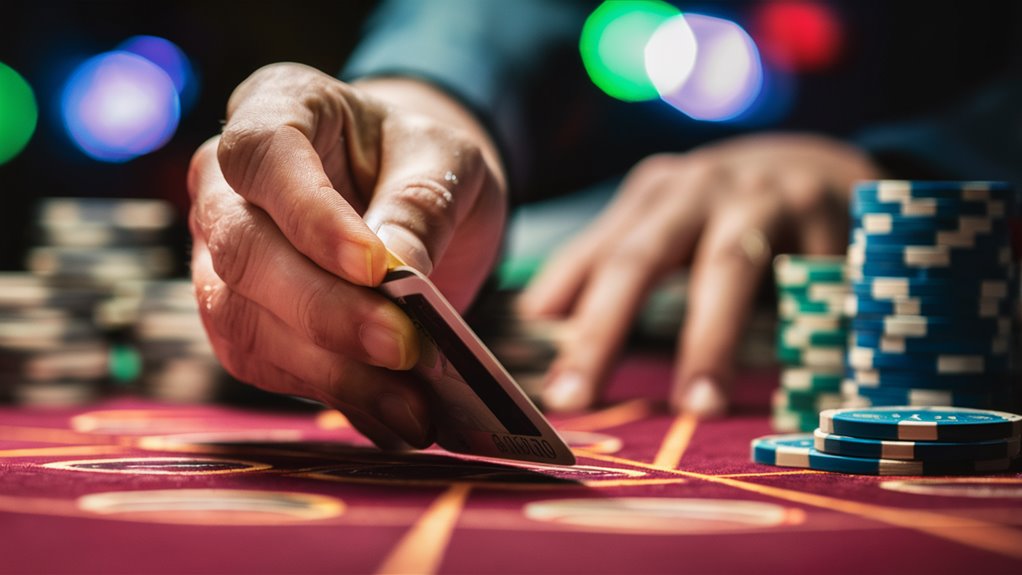
카지노 플레이어가 베팅 슬립 디자인과 충동 행동에 어떻게 노출되는가: 의사결정에 미치는 영향
카지노 심리학: 베팅 슬립 디자인이 플레이어 행동에 미치는 영향
카지노 환경의 전략적 설계
카지노 환경은 감각 자극과 행동 유도를 통해 심리적 취약성을 이용하도록 정밀하게 설계되어 있다. 고대비 색상, 깜빡이는 조명, 계산된 음향 효과는 강력한 도파민 반응을 유도하며 시간 인식을 의도적으로 흐리게 한다. 이러한 환경 요소들은 합리적인 의사결정 과정을 약화시키는 최적의 각성 상태를 유지시키기 위해 작동한다.
베팅 슬립 구조와 의사결정
전략적으로 설계된 베팅 슬립은 베팅 행동을 가속화하기 위한 특정 기법을 포함한다:
- 숙고 시간을 줄이는 퀵픽(빠른 선택) 옵션
- 반사적 판단을 억제하는 원클릭 베팅 기능
- 베팅 금액을 시각적으로 고정시키는 앵커링 요소
- 빠른 베팅을 유도하는 간소화된 인터페이스
플레이어 행동에 영향을 미치는 환경 요인
카지노 환경은 다음 요소들을 정밀하게 제어한다:
- 장시간 편안함을 유지하는 온도 조절
- 각성 상태를 유지하는 주변 소음 수준
- 시간 인식을 흐리는 조명 패턴
- 장시간 플레이 유도를 위한 공기 질 최적화
심리적 유도 요소와 플레이어 보호
일부 보호 조치가 도입되어 있음에도 불구하고, 플레이어는 고도화된 심리적 조작에 여전히 노출되어 있다:
- 경고 메시지는 설계된 유도 요소를 충분히 제어하지 못함
- 예산 제한은 환경적 영향력을 상쇄하지 못함
- 인지 편향은 디자인 요소에 의해 강화됨
- 노출 시간 증가로 인한 의사결정 피로 발생
카지노 내 의사결정에 미치는 영향
이러한 요소들은 복합적인 행동 영향을 유발하여 플레이어의 선택에 체계적으로 작용한다. 조작 기법을 이해하면 카지노 게임 환경 뒤에 숨겨진 정교한 심리 구조와 플레이어 행동에 미치는 영향을 파악할 수 있다.
베팅 슬립 심리학: 도박 행동의 이해
베팅 슬립 설계의 심리적 유도 요소
베팅 슬립은 정교한 심리 메커니즘을 활용하여 베팅 결정에 본질적인 영향을 미친다. 이러한 문서들은 인지 편향과 사고 단축 경로를 활용하여 베팅 빈도와 금액에 영향을 준다.
주요 심리적 요인

앵커링 효과
베팅 슬립 상에 전략적으로 표시된 금액은 강력한 기준점(앵커)을 형성하여 적절한 베팅 규모에 대한 인식을 형성하고 의사결정을 유도한다.
시각적 위계와 주의 집중
디자인 요소는 당첨 가능성에 대한 시각적 강조를 통해 플레이어의 주의를 유도하고, 위험 정보는 최소화한다. 이는 보상 경로를 활성화하고 손실 회피 기제를 약화시킨다.
행동경제학적 영향
선택 항목을 직접 표시하는 과정에서 형성되는 소유 효과는 베팅에 대한 심리적 소속감과 통제감을 유도한다. 사용자 친화적 인터페이스는 베팅에 대한 인지 장벽을 낮춘다.
의사결정 패턴
슬립에 인쇄된 고정 금액은 사용자가 독립적인 수치를 생성하기보다 제시된 선택지에서 고르도록 유도한다. 이는 베팅 프로세스를 간소화하면서 특정 베팅 패턴으로 이끌어간다.
베팅 슬립이 도박 행동에 미치는 심리적 영향
단순해 보이는 문서가 실제로는 정교하게 설계된 유도 메커니즘을 통해 베팅 행동을 상당히 조정하고 있다는 점에서 심리적 영향력은 매우 강력하다.
색채 이론과 플레이어 동기 유발
게임 디자인에 활용되는 색채 심리학
게임 재료에 색채 전략 적용
베팅 자료에 색채 심리를 활용함으로써 플레이어의 행동 유도와 의사결정에 큰 영향을 미칠 수 있다. 특정 색상은 감정적·행동적 반응을 유도하는데 사용된다.
색상의 심리적 효과
- 빨간색: 긴박감과 흥분 유발
- 금색: 성공과 부의 상징
- 주황/노란색: 보상 기대감 자극
- 파란/녹색: 신뢰와 안정감 부여
- 고대비 구성: 정보 처리 최적화
시각 위계 및 결정 구조
고대비 색채 구성은 시각적 명료성을 향상시켜 의사결정 속도를 높이고, 긍정적 결과 시나리오에 주의를 집중시키며 위험 관련 정보는 자연스럽게 축소한다.
도박 결정에서의 인지 편향
시각 요소와 인지 편향이 도박 행동에 미치는 영향
주요 인지 편향
확증 편향
플레이어는 자신이 믿고 있는 ‘행운의 숫자’나 전략에 부합하는 정보에 더 집중하게 된다. 이는 확률 평가의 왜곡을 초래한다.
앵커링 효과
처음 제시된 베팅 금액은 기준점이 되어 이후의 베팅 금액 결정에 지속적인 영향을 미친다. 결과적으로 예상보다 큰 금액을 베팅하게 되는 경향을 만든다.
가용성 휴리스틱
최근의 승리 사례나 아깝게 놓친 경험이 부각될 경우, 해당 결과가 실제보다 더 자주 발생할 것처럼 인식되어 잘못된 기대감을 형성한다.
도박 행동에서의 심리적 기제
- 숫자 선택 기능 등 상호작용 요소는 플레이어에게 통제감 착각을 부여함
- 낙관 편향과 결합 시 승리 가능성을 과대평가하고 손실 가능성은 저평가함
- 현실과 동떨어진 도박 기대를 형성하고 손실 후에도 지속적인 베팅을 유도함
환경 유도 요소와 감각 과부하
카지노 설계에서의 감각 자극 전략
감각 조작의 과학
현대 카지노는 다감각적 환경을 구성하여 플레이어의 인지 기능에 영향을 준다. 조명, 소리, 온도 등을 정밀하게 조합함으로써 플레이어의 판단과 위험 감수 성향을 조절한다.
의사결정에 미치는 영향
- 정신적 에너지 소진: 지속적인 자극이 인지 자원을 고갈시켜 충동 베팅 증가
- 시간 인식 왜곡: 플레이 시간이 인지되지 않아 과도한 체류 유도
- 작업 기억 저하: 전략 유지 및 확률 계산 능력 저하
신경 반응 메커니즘
- 빛과 사운드 동기화로 도파민 반응 유도
- 소음은 손실 사건을 감추며 각성 상태 유지
- 적정 온도 조절로 장기 체류 유도
책임감 있는 게임을 위한 보호 조치

현대 카지노 환경의 필수 안전 장치
핵심 보호 조치
자가 차단 프로그램
플레이어가 자발적으로 도박 접근을 차단할 수 있는 시스템으로, 문제 도박 예방에 효과적이다.
자동 모니터링 시스템
실시간 경고 및 플레이 추적 기능을 통해 장시간 게임 참여를 감지하고 사전 개입 조치를 제공한다.
강제 쿨다운 시간
베팅 세션 간 강제 휴식은 행동 재평가와 건강한 경계 유지에 기여한다.
소통 및 지원 체계
- 도박 자료에 위험 경고 삽입
- 24시간 상담 가능 콜센터
- 현장 상담 서비스
- 재정 관리 도구
- 교육용 자료 제공
이러한 보호 조치는 과도한 베팅으로부터 플레이어를 보호하고, 보다 자율적이고 책임감 있는 도박 환경 조성에 기여한다.





